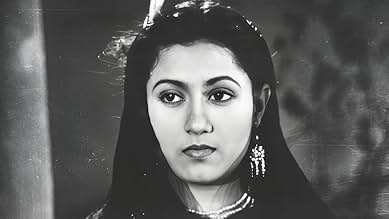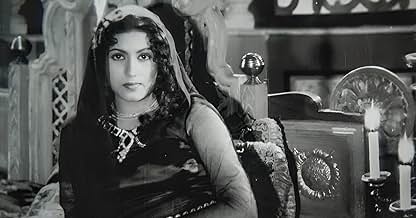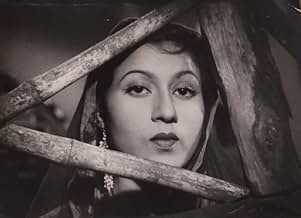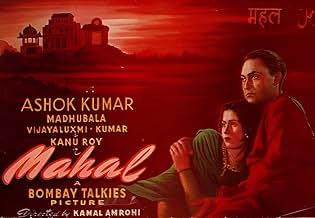Aggiungi una trama nella tua linguaA young lawyer is involved with a ghostly woman in his new house, where the builder and his fiancée died shortly after it was built.A young lawyer is involved with a ghostly woman in his new house, where the builder and his fiancée died shortly after it was built.A young lawyer is involved with a ghostly woman in his new house, where the builder and his fiancée died shortly after it was built.
Recensioni in evidenza
I completed watching the first psychological horror film of India, Mahal (1949). The film of Kamal Amrohi, which catapulted the careers of actress Madhubala and playback singer Lata Mangeshkar, is eerily satisfying to watch and has ambiguities which show the rawness of the plot itself.
The song "Ayega Aane Wala" became a trendsetter, influencing generations of Indian horror cinemas to carry a haunting yet soothing title track. The legendary Ashok Kumar's mental upheaval is portrayed as vaguely as is the aura of the entire "Mahal".
The overall movie seems to be stretchy but the final climax turns the table and makes the audience wonder the skill of Amrohi's direction. Although the film doesn't explain on the existence of supernatural or the haunting coincidence of rebirth, I feel the taste of this dangling doubt leaves a lasting mark on its legacy which went on to inspire classics like Madhumati, Bees Saal Baad, Karz or Om Shanti Om.
Lastly, I observed the prehistoric form of horror storytelling, aptly commendable for the filmmaking of 1949. The takeaway from this movie is definitely the absurdism of storytelling, which thins the line between natural and supernatural, and questions the sanity and extent of human love.
The song "Ayega Aane Wala" became a trendsetter, influencing generations of Indian horror cinemas to carry a haunting yet soothing title track. The legendary Ashok Kumar's mental upheaval is portrayed as vaguely as is the aura of the entire "Mahal".
The overall movie seems to be stretchy but the final climax turns the table and makes the audience wonder the skill of Amrohi's direction. Although the film doesn't explain on the existence of supernatural or the haunting coincidence of rebirth, I feel the taste of this dangling doubt leaves a lasting mark on its legacy which went on to inspire classics like Madhumati, Bees Saal Baad, Karz or Om Shanti Om.
Lastly, I observed the prehistoric form of horror storytelling, aptly commendable for the filmmaking of 1949. The takeaway from this movie is definitely the absurdism of storytelling, which thins the line between natural and supernatural, and questions the sanity and extent of human love.
It has been proud to watch a cult-classic film now in 2021 for the first time and I can trace back the setting and the subject which the movie talks about. The films getting released nowadays have this kind of subject or theme which shows a close resemblance to this 1949 film, Mahal. Debted from gothic culture Mahal set-up in a Mahal (mansion) which has that kind of German Expressionist mise-en-scene and musical accompaniment. I like the songs especially the 'Ayega' song which is resounding in my heart. The great essence of cinematography technique by the veteran Josef Wirsching can be seen here and excellent music composition by Khemchand Prakash. A modernized way of depiction can be seen in each and every frame of the movie.
This is one of the greatest suspense movies of all times in any language. Kamal Amrohi was a genius, who could never reproduce at the same level, as in Mahal, his debut venture. In this respect, he reminds me of Orsen Welles, whose debut venture Citizen Kane was his best, and one of the greatest movie of all times. What upsets me most is that Mahal is considered a ghost story by many commentators. Nothing could be further from truth. It's a great suspense story, told in a straight forward way, and yet exceptionally hard to guess the surprise ending on first viewing. Khemchand Prakash's music is among the finest in Hindi movies. But for his early demise, he would have been as much an icon as Naushad he introduced to Hindi films.
Had seen this as a kid in bits n pieces.
Saw this fully for the first time recently on YouTube. The print is passable but the sound quality ain't good.
The English subtitles helped me a lot to dig this film very well.
The story is about a man Shankar who moves into an old n abandoned palace. He visits the palace on a dark stormy night. He is greeted by the gardener who tells him that the palace was inhabited by a couple forty years back and that the couple died one aft another cos of their intense love. Shankar is astonished when he sees the photo of the old owner which looks exactly like him. Suddenly Shankar hears a woman singing n the moment he approaches her, she disappears. He tells this to his friend n inspite of his friend's advice, Shankar gets drawn towards the mysterious ghost.
One of the best part is this is the first gothic horror from Bollywood n cinematographer Joseph Wirsching nailed it. Ther r some lovely shots from interesting angles, and shots cleverly framed. The lighting is used appropriately. The lead actress Madhubala became one of the most successful and iconic actress of Indian cinema. The film started with good suspense but slowly became a bit melodramatic aft the marriage. There is a pretty lol scene wher the wife follows the husband n she stands next to the husband n the ghost without getting noticed. The mountain top scene of the shack is pretty desolated n creepy. The tribal community's trial n execution is weirdly funny.
The twist is good for first time viewers who dont read synopsis. Very generous with a 9 cos it's a very creative idea n the original Bollywood gothic horror. Apart from the idea where a person falls in love with a dead person's photo (Laura), the entire script is very original.
Some major q's - Why the previous owner came at midnight and left at dawn? Was the gardener involved? What was the need for the gardener to climb n restore the clock? Why didnt Asha show any remorse aft her father's death? Why 2 am? Mayb Kamini used to sleep throughout the day. The wife stopped a different clock at her shack which resulted in affecting the main clock at the palace. How come? Anyways it is a solid attempt n the film is truly a poignant tale of love, destiny n reincarnation.
The story is about a man Shankar who moves into an old n abandoned palace. He visits the palace on a dark stormy night. He is greeted by the gardener who tells him that the palace was inhabited by a couple forty years back and that the couple died one aft another cos of their intense love. Shankar is astonished when he sees the photo of the old owner which looks exactly like him. Suddenly Shankar hears a woman singing n the moment he approaches her, she disappears. He tells this to his friend n inspite of his friend's advice, Shankar gets drawn towards the mysterious ghost.
One of the best part is this is the first gothic horror from Bollywood n cinematographer Joseph Wirsching nailed it. Ther r some lovely shots from interesting angles, and shots cleverly framed. The lighting is used appropriately. The lead actress Madhubala became one of the most successful and iconic actress of Indian cinema. The film started with good suspense but slowly became a bit melodramatic aft the marriage. There is a pretty lol scene wher the wife follows the husband n she stands next to the husband n the ghost without getting noticed. The mountain top scene of the shack is pretty desolated n creepy. The tribal community's trial n execution is weirdly funny.
The twist is good for first time viewers who dont read synopsis. Very generous with a 9 cos it's a very creative idea n the original Bollywood gothic horror. Apart from the idea where a person falls in love with a dead person's photo (Laura), the entire script is very original.
Some major q's - Why the previous owner came at midnight and left at dawn? Was the gardener involved? What was the need for the gardener to climb n restore the clock? Why didnt Asha show any remorse aft her father's death? Why 2 am? Mayb Kamini used to sleep throughout the day. The wife stopped a different clock at her shack which resulted in affecting the main clock at the palace. How come? Anyways it is a solid attempt n the film is truly a poignant tale of love, destiny n reincarnation.
This is classic in real sense of the word. A tight suspense from beginning to end. Mahal is one of the greatest films ever made in Bombay filmdom. Adding to the suspense is all time great song 'Aayega aane wala...'. See it for a very young Madhubala and highly expressive Ashok Kumar. Kamal Amrohi has not made any better movie than this one. Though his 'Daira' is another great hidden classic. He is primarily remembered for 'Pakeeza'. Very few films gained the status this film achieved. This is certainly one of the ten best from Bombay. The story has twisting end which will certainly surprise you and you will never be the same again. Most of the movie was shot indoors, one can easily tell that comparing it to modern standards, yet the directorial perfection is amazing. A must see.
Lo sapevi?
- QuizDuring the recording of the film music, a man carelessly said that if the film didn't prove to be a hit it would be because of the music. When the film was released, however, the music was extremely popular, and music director Khemchand Prakash received letters from all over India. Even though he was ill at the time, Prakash went to that man's house and made him read all those letters.
I più visti
Accedi per valutare e creare un elenco di titoli salvati per ottenere consigli personalizzati
- How long is Mahal?Powered by Alexa
Dettagli
Botteghino
- Budget
- 4.500.000 INR (previsto)
- Tempo di esecuzione2 ore 45 minuti
- Colore
- Proporzioni
- 1.37 : 1
Contribuisci a questa pagina
Suggerisci una modifica o aggiungi i contenuti mancanti






















